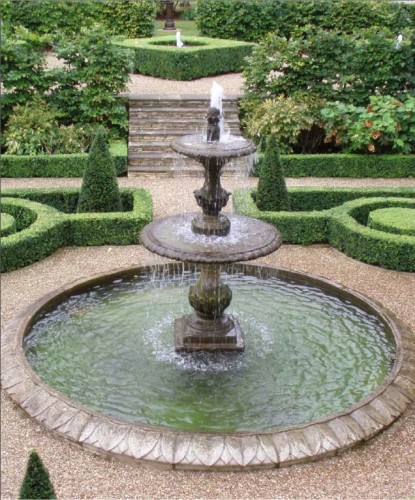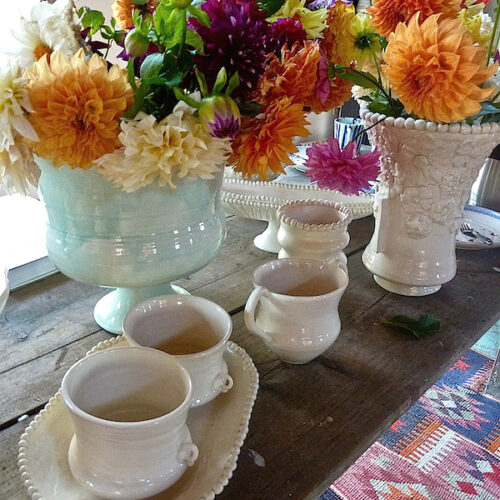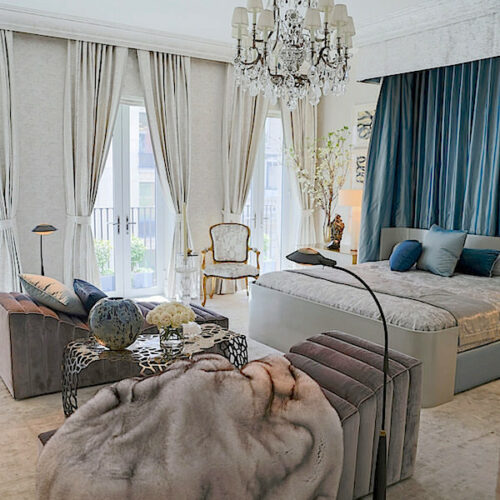 One of my favorite new finds, also discovered at the Architectural Digest Home Show, is the wonderful British company Architectural Heritage. With all the talk of heritage lately, this service oriented family-run business can truly lay claim to the title.
One of my favorite new finds, also discovered at the Architectural Digest Home Show, is the wonderful British company Architectural Heritage. With all the talk of heritage lately, this service oriented family-run business can truly lay claim to the title.

For 35 years they have been sourcing the finest examples of 18th, 19th and early 20th century garden statuary, fountains, urns, seats, sundials etc. as well as beautiful period architectural elements. I love, for example, the circa 1900 pair of Bath stone fruit basket finials above. Their charming decorative quality would enhance a terrace or garden of any design. In fact, there has been a lot of banter in the design world lately about both the aesthetic appeal of an eclectic mix as well as the value of adding authentic antiques. I think this holds true for designing outdoor spaces as well. And Architectural Heritage offers perfect pieces to imbue your garden or terrace with a grounding sense of history whether you have a modern or traditional design.

A lead figure of Neptune by Wheeler Williams (American, 1897-1972), numbered and signed Neptune, No. 40, Wheeler Williams 1939.
Along the way, they have also developed a line of fine reproductions. Based on period designs, they are produced by master craftsmen using traditional techniques. Take for example this classic Lion Mask Wall Fountain. Made of aged patinated artificial stone, it is hard to tell that it is not a vintage original.

The reproductions include not only garden ornament, fountains and statuary, but also authentic hand carved stone chimneypieces. From more intricate works such as this Gothic revival Palace of Westminster limestone example

to the more simplified lines in this Little Aston Hall surround, modeled after a George 1 original from 1720, all can be adapted to bespoke dimensions as requested.
 Take a look at a couple of handsome custom installations to get an idea of the possibilities.
Take a look at a couple of handsome custom installations to get an idea of the possibilities.

There are also interior items of impressive historical significance. The Wynnstay Hall Staircase from circa 1660 rises four flights and is nearly complete. It has a fascinating story which I will not reveal in detail here but suffice it to say that this is a rare example of a period staircase surviving almost intact, through a combination of reuse and storage, from the 17th century.
 Another fabulous historic offering is the Lavenham Ceiling, of oak, circa 1490. Purchased by the William Randolph Hearst Estate in 1926, there was quite a brouhaha at the time over whether an American should be allowed to buy the house and then remove and export the contents to the U.S. Although the British government couldn’t come up with the funds to compete with the purchase, something must have happened since the house was rebuilt in 1929, without however, some of its original features, obviously this ceiling being one.
Another fabulous historic offering is the Lavenham Ceiling, of oak, circa 1490. Purchased by the William Randolph Hearst Estate in 1926, there was quite a brouhaha at the time over whether an American should be allowed to buy the house and then remove and export the contents to the U.S. Although the British government couldn’t come up with the funds to compete with the purchase, something must have happened since the house was rebuilt in 1929, without however, some of its original features, obviously this ceiling being one.

Back to the garden, there are many other possibilities. They currently have quite a few pieces of early 20th century Carre furniture, which I have always loved. Although you may recognize the design, you may not know the name or history. Patented in 1866 by Francois Carre, this bent steel rod and spring construction furniture was produced not only in Paris but also in Vienna and New York. The patent was later purchased by Lalance & Grosjean in New York.


The range of product is wide and deep. Whether you are interested in classic limestone garden ornaments, bronze decorative pieces such as this Zenith Armillary Sphere
 or even a commission such as this recent one to carve in stone a pair of lions after Canova, Architectural Heritage can do it all.
or even a commission such as this recent one to carve in stone a pair of lions after Canova, Architectural Heritage can do it all.
 Owner Alex Puddy tells me that their customer base is both private individuals and professionals purchasing on behalf of their clients. In addition to their stock items, they work with clients on bespoke sizing and custom pieces and can ship worldwide. Their catalogues are works of art themselves and include wonderful historical information on every category they carry.
Owner Alex Puddy tells me that their customer base is both private individuals and professionals purchasing on behalf of their clients. In addition to their stock items, they work with clients on bespoke sizing and custom pieces and can ship worldwide. Their catalogues are works of art themselves and include wonderful historical information on every category they carry.
In addition, they produce three other incredibly charming volumes. The first is The Shell Seat. Any of you familiar with British architectural history will know that Horace Walpole was responsible for building Strawberry Hill, the famous example of Georgian Gothic revival. Walpole’s extravagance and romantic allusions are perfectly envisioned in his Shell Seat, designed by friend Richard Bentley. Although no one knows exactly what happened to the seat, original drawings remain.

courtesy of The Lewis Walpole Library, Yale University
I love the idea that Architectural Heritage decided to reproduce this whimsical piece of history. Here is one version of Roy Waddingham’s working drawings from last year.
 And here is a shot of the finished modern Shell Seat which has been limited to an edition of 101. Each receives a bronze numbered medallion with the Strawberry Hill Trust logo and the owner’s name is recorded in a record book kept at Strawberry Hill.
And here is a shot of the finished modern Shell Seat which has been limited to an edition of 101. Each receives a bronze numbered medallion with the Strawberry Hill Trust logo and the owner’s name is recorded in a record book kept at Strawberry Hill.

The second volume, entitled Poetry in the Garden, includes an eclectic anthology of poetry paired with images of antique garden ornaments – a total delight! Here one of a pair of 18th century Portland stone roundels depicting Clio, the muse of history, with her book (The Histories by Heroditus), a stylus and a swan is paired with a Tolkien verse, reproduced below. I chose this pairing for my friend Gaye at Little Augury who delights in such historical musings, and whose personal muse of choice is Clio.


 The last book, Connected, records an exhibit based on Puddy’s incredible collection of 20th century sculpture , including such notable artists as Jacob Epstein and Henry Moore.
The last book, Connected, records an exhibit based on Puddy’s incredible collection of 20th century sculpture , including such notable artists as Jacob Epstein and Henry Moore.

I had not intended for this to become a treatise, but there is just so much at Architectural Heritage to explore. If you are interested in learning more about this very interesting company, you can find them at:







So gorgeous and grand! It makes me long for more space in our small LA backyard! Hugs xx
Absolutely romantic and lovely! The mantels were my favorite!!!
http://bjdhausdesign.blogspot.com/
Wow! What an amazing company. Thanks for the introduction Q!
Wonderful wonderful post!!!! I know this company since a few years! They really have the most wonderful architectural antiques!!
That fireplace with the wood paneling around here is just gorgeous!!
Thank you so much for sharing this!!
xx
Greet
Alex Puddy’s booth was next to us and he was such a joy to converse with. Beautiful products!
The carre furniture and chimney pieces are gorgeous! Looking at beautiful examples of sculpture/decor always make me feel better.
xoxo,
Chic ‘n Cheap Living
This company sounds fantastic and after reading this post Im daydreaming about having a lovely garden:) Have a sunny Monday my dear
Kisses
Ps: I’m hosting a super cute Ruche GIVEAWAY later today! Hope you’ll join in :)
Love their work. The fountain is stunning. One day, one day, I’ll have a garden to enhance with sculptural things like these.
yes,very beautiful and elegant heritage architectural pieces…
..the the chimney pieces are simply divine…
I’ll take one of each, thank-you… :)
maureen
Those Carre pieces are absolutely stunning, I would love to have them in our little garden!!
LOVE, LOVE, LOVE!
Their booth was one of my favorites.
And I have been fantasizing about a grand British house and garden with a shell seat!
Lynn
Must get to work on my yard now that it’s getting warm. In the market for a armillary sphere and this one is gorgeous!!
Digesting architectural detail is so fulfilling isn’t it?! I have missed your lovely in depth posts :) That shell seat is so dramatic, I just love it!! XO, Kelly
I get weak at the knees staring at beautiful garden statuary (have a post tomorrow on it) so thats always a treat, those mantles are stunning and love anything with a gothic influence and of course that antique stair is incredible! Thanks for telling us about this resource..it is adding elements like this to even brand new homes that gives them instant character, a sense of authenticity and history. Beautiful!
What an utterly fabulous discovery. We are both fiends for architectural salvage shops, so this just makes my inner architect (ahem) grin from ear to ear. Thank you for starting the week off on such a lovely note!
Sending you a smile,
tp
I love a well appointed garden.. Architecture is so important. I absolutely adore the armillery. The figures, fountains and planters are also quite lovely. There is a real art to incorporating all those elements into a landscape..
Great post …
Love it! Now I’m dreaming of a grand garden, and sitting on one of the Carre chairs, enjoying the sunshine and the scent of old garden roses…
Thanks for this great post. I have wonder for years about the origins of the Carre garden furniture–I wish I had bought some when it was affordable. Although Hearst may have been unable to purchase the ceiling above, he certainly amassed a wealth of other European Renaissance architectural elements. Some made it to San Simeon; others (like those used in the building of my high school in Mexico) traveled to all parts of the world.
LOVE this post! I moved from my house to a townhouse (read: no garden) and am happy to have given up all the work. But I still love these garden accessories. I do have a small sun-room that now houses my Astrolabe and small statues among the house plants. I even have pictures depicting urns and small garden urn ornaments for the room, hand painted tiles on a console and such. It helps in keep the orderly world of a garden in spirit. But I could totally do the mantle. Mine is ok but not as grand as those you showed. Something to think about!
Dear Stacey,
Thank you for this “treatise!” It’s interesting, informative and beautiful postings like this that made me decide to become part of the blogging community. (I would have guessed the Francois Carre furniture was from the 1920s or 1930s.)
I will take one of each please. I love garden sculptures and beautiful planters. Fountains are my favorites. Do tranquil.
Thanks for sharing this company.
Teresa
xoxo
Loving all of this garden inspiration! Can’t wait for spring to officially blossom here already!
OOH, I’m salivating over those mossy urns in the first pic. Beautiful things that just make the garden. I’m going to check this resource out. thanks. Mona
The shell seat is quite the focal point. It would make a fabulous at the center back of my yard, just behind the boxwood parterre with the center urn. I’ll have to wait until the Luytens bench deteriorates. Love this post. Thanks.
I have 3 concrete garden pedestals (very large) which are all alike but varying heights, with 3 similar but different huge urns sitting atop. These are my most precious garden elements and I never ever tire of them. This post is amazing in it’s wealth of information and thoroughness, S. I loved reading it and seeing all the drawings. xx’s
That seashell bench…WOW! Love it! I love anything architectural, those fireplaces are amazing! Love this post!
These are incredible accents for the garden! I would take one of each!!! We are waiting to really do our backyard garden until we complete our renovation….so these will just have to go into the inspiration file for a while!
The Bath stone fruit basket finials are my favorites. I love garden ornamentation and this is some of the most beautiful I have ever seen!
Loved reading this post not only for the photos of garden decorative elements, but also for the historical content.